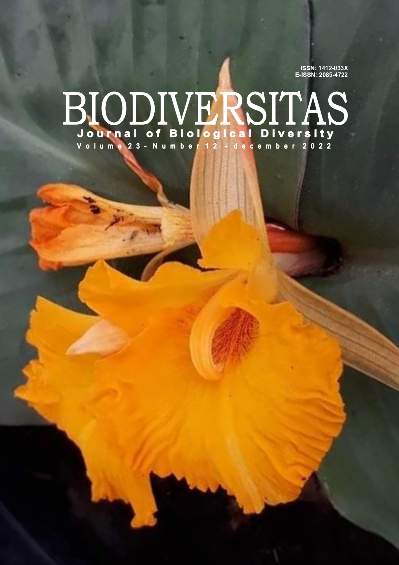Selection of probiotic candidate of lactic acid bacteria from Hermetia illucens larvae fed with different feeding substrates
##plugins.themes.bootstrap3.article.main##
Abstract
Abstract. Siregar DJS, Julianti E, Tafsin M, Suryanto D. 2022. Selection of probiotic candidate of lactic acid bacteria from Hermetia illucens larvae fed with different feeding substrates. Biodiversitas 23: 6320-6326. Exploration of probiotics candidate have been accelerated from unique and novel source, one of which is from black soldier fly (Hermetia illucens). The black soldier flies are known as omnivores which are commonly reared, harvested and utilized to convert organic wastes into biomass yet reducing the amount of abundant waste in nature. Lactic acid bacteria (LAB) is one of beneficial gut symbionts which can be found across animal taxa, including insect, however, limited information is currently reported from H. illucens as a potential harboring insect. This study aimed to determine the probiotics candidate from the gut of H. illucens fed with different feeding substrates to improve the gut microbiota. The larvae were nourished with chicken manure, tofu solid wastes and vegetable wastes prior isolation of LAB. The LAB isolates were tested for their antagonistic activity against enteric pathogens, pH and bile salt tolerance, and adherence to chicken intestine (ileum). Based on the growth performance under physiological stresses and multivariate analysis using principal component analysis (PCA), four LAB isolates were designated as putative probiotics. The four isolates were Lactiplantibacillus. pentosus 5P2i1, Lacticaseibacillus. paracasei 5P2i5, Lactiplantibacillus. pentosus 5P2i9, and Lactiplantibacillus. plantarum 6P1i1 was then declared as novel strains that could be developed further as poultry probiotics.
##plugins.themes.bootstrap3.article.details##
Most read articles by the same author(s)
- RIDWANTI BATUBARA, T. ISMANELLY HANUM, ODING AFFANDI, ELISA JULIANTI, MARIAH ULFA, The antioxidant activities and chemical compounds of Aquilaria crassna, Aquilaria microcarpa, and Gyrinops versteegii leaves growing in Langkat, North Sumatra, Indonesia , Biodiversitas Journal of Biological Diversity: Vol. 23 No. 12 (2022)
- ALPINA BUKHORI, DWI SURYANTO, KIKI NURTJAHJA, Biosurfactant activity of phylloplane bacteria from an ornamental plant, Colocasia esculenta L. , Biodiversitas Journal of Biological Diversity: Vol. 23 No. 6 (2022)

